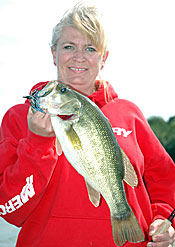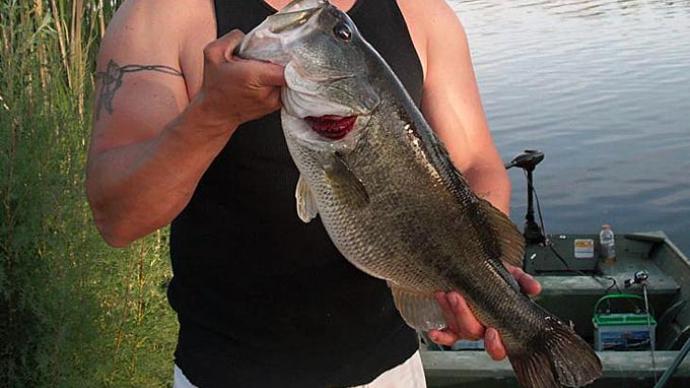
You can't win a golf match with just the long sticks alone. You have to be good at the short game, rounding out your game. Well, you can say the same thing about fishing. Sometimes you can catch all the fish by making long casts to an open water hump. But often, there are days when you will have to shorten up your game and work heavy cover to catch your share of bass.
Bass fishing is a game of many different tactics and patterns, and not all of them are based on the longest casts you can make. Many new and some older presentations are based on short pitches and flips. Getting toe-to-toe with the bass is a viable tactic to take bass across the board when bass are buried deep in cover.
Heavy cover can hold bass regularly, and fishing these areas with traditional tackle is a risk in itself. When you go toe-to-toe, you have to get into their element. Spinning rods and lighter equipped baitcasters are traded for flippin' sticks and heavier line sizes in these conditions, and braided line is standard in many cases. To get into this cover, you will have to fish baits that will enable you to get a good solid hook set and get the bass out of the deepest of cover fast. Many times this choice leads to a jig.
What started as a flippin' presentation many years ago has changed throughout the years. Fishermen no longer use a pendulum swinging a lure to drop it into a hole next to cover locations with a soft landing. This has been replaced in today's bass fishing by a shorter pitching style of delivering baits into target areas. By taking the bait in one hand and raising the rod from the 5 o'clock position to the 12-noon position, the weight of the lure carries the bait out to the target. By changing to this presentation, you can offer a greater distance covering more water with ease and better accuracy with less water commotion from your boat. With traditional flippin' styles, you had to move your boat into position to put your lure next to cover. With pitchin', you can hold the boat back and still get your bait to your target location.
When fishing milfoil, a pitchin' presentation will stand out as the best way to deliver your bait to the bass. Looking at a flat of milfoil that can be as big as city blocks, you have to ask, where do I start? Inside turns, and drop-off areas close to deep water are vital to check first. Another way to dissect the milfoil flat would be to work specific depth contours. For example, start at a certain depth - say 12 feet - and work that contour line throughout the flat. Along the way, keep a close eye on your electronics, looking for crucial bottom changes or depth changes. Fish this process from deep to shallow until bass contact is made.
As you move along the milfoil flat, pitch your bait into the pockets and gaps you see in the milfoil. These pockets will allow the jig to fall straight down to get into the strike zone. You can try to put the jig through the blanket of foil matted on the surface. But to tell you the truth, you will get fouled more than you will be able to get the bait down to the bass for a clean presentation. You will be more successful and fowl less if you pitch to the pockets in the foil.
When bass contact is made, throw a marker or create a waypoint on your GPS so that you can stay close to this area. Make a mental note of the depth and bottom content when you contact a fish. Work the area around your marker as chances are pretty good that there are more bass close by. Once you're done working this area, move to another, and you can pretty much dial in the bass now that you have a starting point.
Picking baits for this challenging presentation, you will need a jig that will get through the milfoil with ease and won't foul when being fished or brought back through the milfoil. Outkast's RT Jig is the jig I fish. Team the RT Jig with an Outkast Chunk, and you have a milfoil combo that is hard to beat. The RT Jig's bullet-shaped head glides through the weeds, and the sunken eye makes it even harder to get hung in the milfoil.
Fishing the jig is easy. Make your pitch to the opening and let the jig sink to the bottom. Once on the bottom, your line will go slack. Put a little pressure on the jig to make sure a bass did not hit the jig on the fall. If so, set the hook. If not, give the jig a few shakes with the rod tip, then let sit. Again feel for a hit. If not, give it a few more shakes. If there are no takers, it's time to get the jig into another hole. Reel up the jig and pitch it into another gap in the foil.
When it comes to equipment, don't skimp on weight. You will need a good flippin' stick, matched with a baitcaster reel, spooled with either 20-pound mono line or higher, or braided line. You make the choice.
So the next time the bass get a little bit sensitive, bury up deep in cover and won't come out, grab yourself a handful of jigs and head on in after them. You will see how effective toe-to-toe bassin' is and how fun it's to feel the bite, set the hook, and the battle is on. Soon you will have a new respect for just how much power a 5-pound bass has buried up in the foil.




